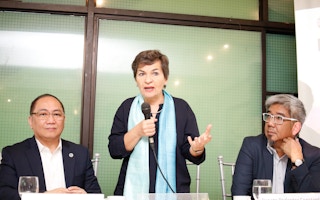Christiana Figueres, the woman who led the negotiations in the groundbreaking Paris Agreement as executive secretary of the UN Framework Convention on Climate Change, steered almost 200 nations through the most complex international deal ever attempted four years ago.
But in her current job as convenor of Mission 2020, a global initiative to curb fossil fuels by the crucial date of 2020, Figueres faces another challenge: stopping coal in Asia, where most of the world’s coal is being mined and burned to generate energy for the world’s fastest growing economies.
As part of the mission’s Asian tour, Figueres was in Japan, the Philippines, and is in Indonesia this week.
Figueres said the shift away from coal—the single biggest source of greenhouse gas emissions—for these three coal-dependent countries is expected to be complicated as they have relied on the fossil fuel for many years.
But compared to Japan and Indonesia, the Philippines is predicted to have the highest share of coal in its power mix in Southeast Asia 12 years from now.
Coal-fired power plants are currently the Philippines biggest source of electricity with an existing capacity of 7,419 MW. The Philippines also imports 75 per cent of its coal, and ranks 10th in the world for planned coal-fired capacity.
Despite the country’s tax hike on coal last year, the government continues to support coal expansion.
International and local investors have also poured in billions of dollars into the island nation’s coal industry helping it to thrive.
Amid these challenges, Figueres is pushing for the Philippines to step up its transition away from coal, a major source of pollution and the single biggest source of greenhouse gas emissions globally.
“
Full electrification of the Philippines can be attained with modular renewables such as small micro grids and rooftop solar.
Christiana Figueres, convener, Mission 2020
“I don’t think that the Philippines can afford to use coal forever because those assets will lose value and they will not be able to operate profitably,” she told Eco-Business.
In this interview, the former UN climate chief assesses the energy landscape in the Philippines, its challenges, and why holding on to coal makes no sense.
How are you creating awareness of renewable energy in the Philippines, a country where coal is supported by the government and business?
The market structure of electricity was built for fossil fuels. It is very difficult to move away from a structure with high capital expenditure and high operating expenditure, because you need to allow for variability in the price of fuel, and owners of plants never know what the fuel price is going to be.
If you move to another system where you have upfront investment cost but the fuel cost is zero, that’s a very different financial structure that is not being considered currently in most electricity markets. That needs to change as renewable energy all over the world is now cheaper than coal.

Figueres with Department of Finance Secretary Sonny Dominguez. Image: Figueres’ Twitter account
There are renewables that are available 24/7 like hydro and geothermal, but solar and wind are not 24/7, so they need to be compensated for. But they have completely different characteristics. The system will have to adapt for them because we just don’t have any more carbon space left in the carbon budget for the fossil fuels that we’re burning.
What is your advice for the Philippine government on how to transition to clean energy?
I’m 62 years old and I have two daughters and I don’t give advice to my daughters or to governments. The only thing that I do is bring out the facts and they have to make their own decisions.
The reality that is facing a country like the Philippines is that it already has 30 per cent renewables in its energy mix, but still has many areas without electricity.
The easiest way to provide electricity to all Filipino households is obviously renewable energy, because then you don’t have to pull from the grid, you don’t have transmission lines or have to worry about distribution. That has to be paired up with battery storage so electricity is available at all hours of the day.
But that is entirely doable so full electrification of the Philippines can be attained with modular renewables such as small micro grids and rooftop solar.
There is also the big question of what’s going to happen with on–grid electricity where there is still a high projected use of coal, which is using up a lot of the country’s manpower and resources.
If you are importing three quarters of the coal that you need, then you are dependent on another country‘s willingness to sell you the coal. And you’re dependent on expensive foreign exchanges because you have to use your national budget to buy the coal. That doesn’t make sense to me if you have other indigenous sources of energy.
Finally, the more coal investments there are, the higher the danger of a negative hit to the economy because of stranded assets—when coal assets lose their value.
The Philippine Department of Energy (DOE) and Meralco have pending coal plant projects. What was your meeting like with them?
I was not expecting to get any commitments from them. It was just a conversation to understand the complexity and direction in which they were moving. The government has a coal tax, it’s a small tax but gives a good signal to corporates about the future direction they need to take.
We also talked about how to use small scale renewables to provide electricity for 100 per cent of the population, and how to shift the risk of high fuel prices away from consumers to the [power] generators. If fossil fuel prices rise again, it should be the generators who absorb that risk not consumers.
The DOE chief has said the country will not move away from coal. Did you get that sense during your visit here?
No, I did not. The fact that coal is cheap in the Philippines is only the result of how the electricity market is structured. It is not the cheapest per se. Renewables are cheapest, but you need to restructure the market to allow sources to compete in a transparent way. Once the risk of fuel prices is shifted from consumers to generators, that would create a more level playing field for renewables.
How can the Philippines shift away from coal?
Coal plants cannot be scrapped overnight because it will throw off the economy. There has to be a smooth transition where old coal plants are closed, because they do not contribute to the health of the energy system.
The most important thing is not to allow new plants that are under assessment—that’s the first step. It will take 20 to 30 years before the owners recuperate their investment, and in that time the Philippines will not be using any coal.
Do you see the shift away from coal happening in Asia?
Well, it certainly is in China, India, and Europe. Coal plants are being closed because they are inefficient. Some are not functioning, they are just sitting there. New plants in the pipeline are the problem. That’s where the economic and environment risk is, and where the big jump in greenhouse gas emissions will come.

















